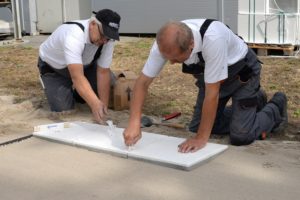Depending on the location and destination, one of the following methods can be used:
Laying without filling joints – subsurface water drainage
- Laying on spacers

The simplest and at the same time the cheapest technique is to lay tiles on height-adjustable pads. With this solution, you save time and minimize your workload. The spacers on the washers create a perfectly even joint, and the washers compensate for unevenness in the substrate. Laying is carried out directly on a watertight layer (e.g. insulating felt) or concrete screed. This method is used on terraces, balconies, loggias and winter gardens.
- Stacking on plastic bags with mortar
A plastic bag filled with damp cement mortar should be placed where the corners of the four tiles meet. It is worth using a cross to keep the joint between the tiles to the same width. Until the mortar hardens, any unevenness can be corrected by hammering the tiles with a rubber mallet.
- Laying on a layer of gravel
On the waterproof layer, apply gravel with a grain size of 2-8 mm (layer thickness min. 5 cm). After leveling it to the desired level of the terrace, lay tiles on it.
With the use of the above-mentioned laying methods, the joints are left unfilled. Rainwater gets into the waterproof layer, where it is drained.
Laying with joint filling – surface water drainage
- Laying on natural substrate
When using this method, a very important activity is to remove the humus layer to the depth of a stable, permeable substrate, used for drainage and constituting a load-bearing layer.
On the substrate prepared in this way, we apply min. An 8 cm layer of cement mortar with a moist consistency, on which, after levelling, we lay the tiles, finishing them off with a rubber mallet. Grouting is performed with cement mortar applied directly to the joint (it is not allowed to sludge the surface of tiles, especially sandblasted and washed
tiles).
- Laying on a concrete slab
On the moistened concrete slab, we apply a layer of cement mortar with a thickness of min. 3 cm (dense plastic consistency). Pour the cement laitance on the leveled mortar and lay the tiles, hammering them with a rubber mallet. Grouting as above.
All methods require a weld width of approx. 5 mm. Areas over 50 m² require expansion joints. It is also necessary to dilatate the terraces from the walls of the building.
source: Probet-Dasag
